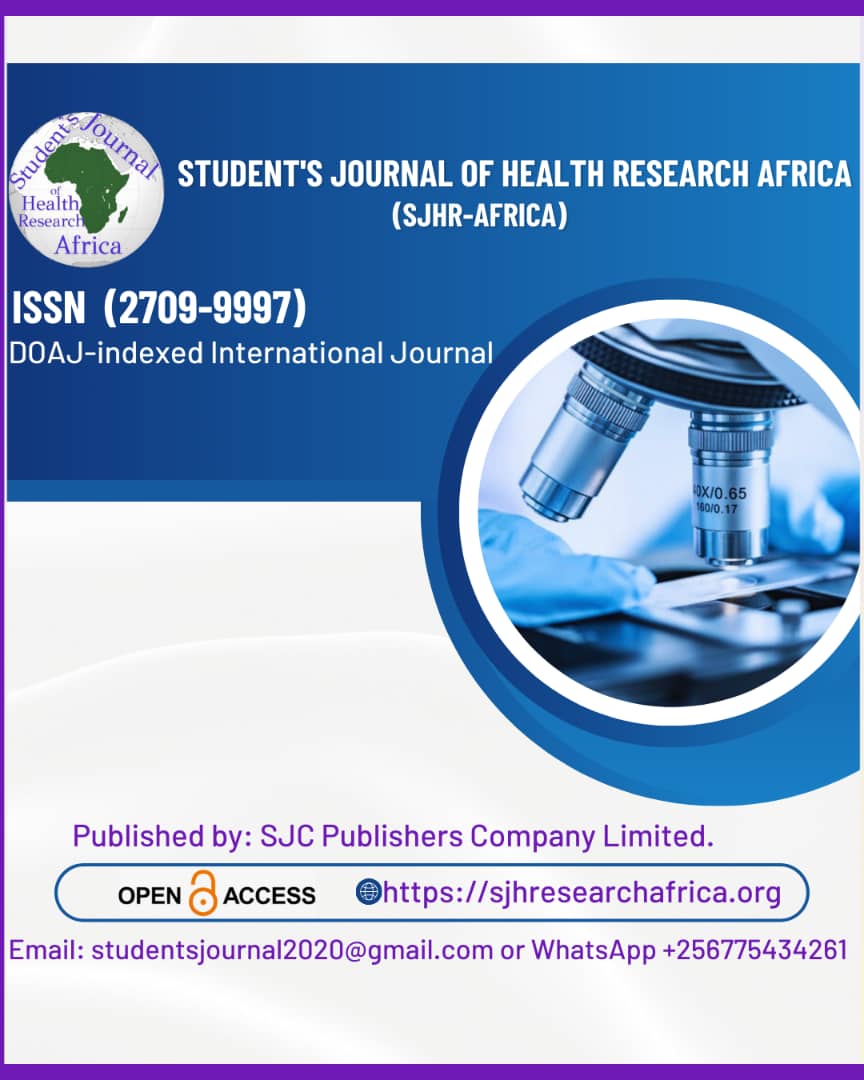Diagnostic accuracy of routine anomaly scans in identifying congenital malformations during the second trimester. A cross-sectional observational study.
DOI:
https://doi.org/10.51168/sjhrafrica.v6i9.2069Keywords:
Congenital malformations, anomaly scan, diagnostic accuracy, prenatal screening, second trimesterAbstract
Background:
Congenital malformations remain a leading cause of neonatal morbidity and mortality worldwide. Early detection through routine anomaly scans during the second trimester is critical for timely counseling, management, and improving pregnancy outcomes. However, the diagnostic accuracy of these scans varies depending on the type of anomaly and the expertise of the examiner.
Objective:
To evaluate the diagnostic accuracy of routine second-trimester anomaly scans in detecting congenital malformations when compared with postnatal findings.
Methods:
A cross-sectional observational study was conducted among 100 pregnant women undergoing routine anomaly scans between 18 and 22 weeks of gestation. Findings were compared with postnatal examinations and confirmatory investigations. Sensitivity, specificity, predictive values, and overall diagnostic accuracy were calculated.
Results:
Out of 100 cases, routine anomaly scans detected congenital malformations in 18 fetuses (18%). Postnatal evaluation confirmed 20 malformations, including 16 true positives, 2 false positives, and 4 false negatives. Sensitivity was 80%, specificity 97.6%, positive predictive value 88.9%, negative predictive value 95.2%, and overall diagnostic accuracy 94%. Central nervous system anomalies were most common (6%), followed by cardiac (6%), skeletal (5%), renal (3%), and gastrointestinal anomalies (2%). Missed anomalies were primarily subtle cardiac and skeletal malformations.
Conclusion:
Routine second-trimester anomaly scans demonstrate high diagnostic accuracy, particularly for central nervous system and renal malformations. However, cardiac and skeletal anomalies remain challenging and require meticulous evaluation.
Recommendations:
Enhanced operator training, incorporation of advanced imaging techniques, and standardized protocols are recommended to improve detection rates of cardiac and skeletal anomalies during routine anomaly scans.
References
Buijtendijk MF, Bet BB, Leeflang MM, Shah H, Reuvekamp T, Goring T, et al. Diagnostic accuracy of ultrasound screening for fetal structural abnormalities during the first and second trimester of pregnancy in low-risk and unselected populations. Cochrane Database Syst Rev. 2024 May 9;5(5): CD014715. Doi: 10.1002/14651858.CD014715.pub2. PMID: 38721874; PMCID: PMC11079979. https://doi.org/10.1002/14651858.CD014715.pub2
Jabaz D, Jenkins SM. Sonography 2nd Trimester Assessment, Protocols, and Interpretation. [Updated 2023 Nov 12]. In: StatPearls [Internet]. Treasure Island (FL): StatPearls Publishing; 2025 Jan-. Available from: https://www.ncbi.nlm.nih.gov/books/NBK570574/
Todros T, Capuzzo E, Gaglioti P. Prenatal diagnosis of congenital anomalies. Images Paediatr Cardiol. 2001 Apr;3(2):3-18. PMID: 22368596; PMCID: PMC3232499.
Fadda GM, Capobianco G, Balata A, Litta P, Ambrosini G, D'Antona D, Cosmi E, Dessole S. Routine second-trimester ultrasound screening for prenatal detection of fetal malformations in Sassari University Hospital, Italy: 23 years of experience in 42,256 pregnancies. Eur J Obstet Gynecol Reprod Biol. 2009 Jun;144(2):110-4. doi: 10.1016/j.ejogrb.2009.02.045. Epub 2009 Mar 25. PMID: 19324492. https://doi.org/10.1016/j.ejogrb.2009.02.045
Karim JN, Campbell H, Pandya P, et al. Clinical and cost-effectiveness of detailed anomaly ultrasound screening in the first trimester: a mixed-methods study. Southampton (UK): National Institute for Health and Care Research; 2025 May. (Health Technology Assessment, No. 29.22.) Chapter 4, Systematic review of the diagnostic effectiveness of early anomaly screening in the prediction of congenital anomalies. Available from: https://www.ncbi.nlm.nih.gov/books/NBK615203/
Wayne C, Cook K, Sairam S, Hollis B, Thilaganathan B. Sensitivity and accuracy of routine antenatal ultrasound screening for isolated facial clefts. Br J Radiol. 2002 Jul;75(895):584-9. Doi: 10.1259/bjr 75.895.750584. PMID: 12145131. https://doi.org/10.1259/bjr.75.895.750584
Yu X, Liu F, Gao W, Shi X, Lu R, Pan L. Diagnostic Value and High-Risk Factors of Two-Dimensional Ultrasonography Combined with Four-Dimensional Ultrasonography in Prenatal Ultrasound Screening of Fetal Congenital Malformations. Comput Math Methods Med. 2022 Jul 12;2022:7082832. Doi: 10.1155/2022/7082832. PMID: 35866037; PMCID: PMC9296308. https://doi.org/10.1155/2022/7082832
Carmen Prodan N, Hoopmann M, Jonaityte G, Oliver Kagan K. How to do a second-trimester anomaly scan. Arch Gynecol Obstet. 2023 Apr;307(4):1285-1290. doi: 10.1007/s00404-022-06569-2. Epub 2022 May 11. PMID: 35543741; PMCID: PMC10023640. https://doi.org/10.1007/s00404-022-06569-2
Zile-Velika I, Ebela I, Folkmanis V, Rumba-Rozenfelde I. Prenatal ultrasound screening and congenital anomalies at birth by region: Pattern and distribution in Latvia. Eur J Obstet Gynecol Reprod Biol X. 2023 Sep 15;20:100242. Doi: 10.1016/j.eurox.2023.100242. PMID: 37771958; PMCID: PMC10522966. https://doi.org/10.1016/j.eurox.2023.100242
Akinmoladun JA, Ogbole GI, Lawal TA, Adesina OA. Routine prenatal ultrasound anomaly screening program in a Nigerian university hospital: Redefining obstetrics practice in a developing African country. Niger Med J. 2015 Jul-Aug;56(4):263-7. Doi: 10.4103/0300-1652.169705. PMID: 26759511; PMCID: PMC4697214. https://doi.org/10.4103/0300-1652.169705
Liastuti LD, Nursakina Y. Diagnostic accuracy of artificial intelligence models in detecting congenital heart disease in the second-trimester fetus through prenatal cardiac screening: a systematic review and meta-analysis. Front Cardiovasc Med. 2025 Feb 24;12:1473544. Doi: 10.3389/fcvm 2025.1473544. PMID: 40066351; PMCID: PMC11891181. https://doi.org/10.3389/fcvm.2025.1473544
Yehudit Z, Rachel MC, Ari W, Ori S, Eyal M, Yitzhak SH. Detection Rate of Fetal Anomalies in Early Mid-Trimester Compared to Late Mid-Trimester Detailed Scans: Possible Implications for First-Trimester Sonography. J Clin Med. 2024 Sep 27;13(19):5750. Doi: 10.3390/jcm13195750. PMID: 39407810; PMCID: PMC11476993. https://doi.org/10.3390/jcm13195750
Downloads
Published
How to Cite
Issue
Section
License
Copyright (c) 2025 Chhani Lal Narsingh Sidar, Dr. Vidya Laxmi

This work is licensed under a Creative Commons Attribution-NonCommercial-NoDerivatives 4.0 International License.





















